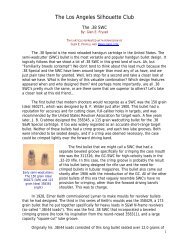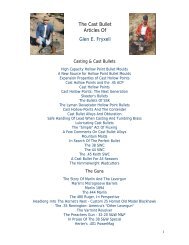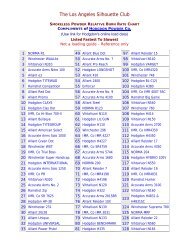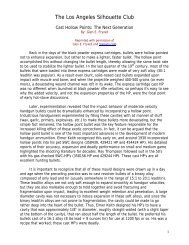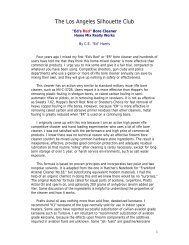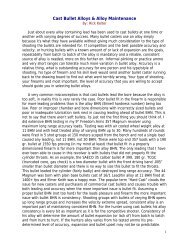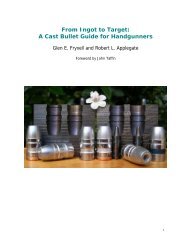The Los Angeles Silhouette Club - LASC Front Page
The Los Angeles Silhouette Club - LASC Front Page
The Los Angeles Silhouette Club - LASC Front Page
You also want an ePaper? Increase the reach of your titles
YUMPU automatically turns print PDFs into web optimized ePapers that Google loves.
article is on the optimum small game hunting<br />
loads, generally operating in the 900-1000 fps<br />
range, and these loads are entirely unsuitable<br />
for the old top-break guns. That brings us to the<br />
Hand Ejectors -- as this is written, I have no<br />
first-hand experience with the Model 1896 (I<br />
hope to change that in the near future), but I<br />
have plenty of experience with the Model 1903<br />
(and the various changes associated with that<br />
Model). This dainty little I-framed sixgun is just<br />
about the definitive "grouse gun" in my mind --<br />
light, easily carried in a vest pocket or bib<br />
.32 S&W Long ammo, loaded with a few<br />
of the excellent cast bullet designs<br />
available (l-r: NEI #75 wadcutter, RCBS<br />
.32-90-Cowboy bullet, Lyman 313445,<br />
Lee custom Group Buy 98 grain Keithstyle<br />
SWC, Mountain Molds Keith-style<br />
98 grain SWC, RCBS 98 grain SWC, and<br />
the Ideal 31133 HP).<br />
overalls when hunting big game, and able to dispatch a grouse quickly and cleanly<br />
without wasting a lot of meat (and without making a lot of noise). <strong>The</strong> Model 1903<br />
was available with 3 1/4", 4 1/4" and 6" barrels. I have shot all three, and they have<br />
all shot very well for me. <strong>The</strong> one issue that I've encountered is that the sights are<br />
rather fine, and with bifocals sometimes it can be a challenge to quickly get a good,<br />
clean sight picture. But these little I-frames sure do shoot! <strong>The</strong> 3 1/4" I have has a<br />
bore that still has decent land/grooves, but is spider-webbed with pitting throughout<br />
the length of the barrel -- and it will still put 12 shots into 1 1/4" at 50 feet! <strong>The</strong><br />
other I-frame .32 S&W Longs I've shot have displayed similar capabilities. I ran some<br />
tests on 4 different I-frame .32 S&W Long revolvers -- all 4 guns would allow a<br />
Hornady 85 grain XTP (that mikes .312" on the nose) to pass smoothly (the 3 1/4"<br />
Model 1903 was a little snug, but it still passed), and none would allow a cast bullet<br />
sized .313" to pass. Clearly, a good place to start with cast bullets for these little<br />
guns is .312".<br />
<strong>The</strong> I-frame .32 S&W Long (Model 1903) was<br />
available with 3 1/4", 4 1/4" and 6" barrels.<br />
S&W built the I-frame (and the<br />
improved I-frame) up until 1961, when they<br />
introduced the J-frame. By this point, the<br />
revolver was known as the Model 30 (round<br />
butt) or Model 31 (square butt). Years ago,<br />
I picked up a 3" Model 31, and it not only<br />
shoots to the fixed sights, it groups quite<br />
nicely to boot! I haven't carried this little J-<br />
frame very often because it's just too pretty<br />
to get beat up when I'm in the black timber<br />
hunting elk, but it has nonetheless<br />
accounted for a handful of vermin and small<br />
game in the off-season. Throats on this revolver run<br />
just a little over .313", so that's what I size cast bullets<br />
when I'm loading for it.<br />
S&W also built a few .32 S&W Longs on the K- <strong>The</strong> J-frame .32 S&W Long<br />
frame. <strong>The</strong>se tend to be rather rare, and you don't run (Model 31-1), with a 3"<br />
barrel and fixed sights.<br />
across them every day. I was fortunate to pick up a 4"<br />
M&P in .32 S&W Long a while back, and it has quickly turned into one of my personal<br />
4



